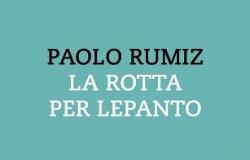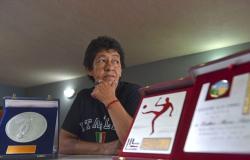Is titled Two Here / To Hear the exhibition project for the Italian Pavilion at the 60th International Art Exhibition of the Venice Biennale (20 April – 24 November 2024), promoted by the General Directorate for Contemporary Creativity of the Ministry of Culture. Edited by Luca Cerizza (with the assistance of Francesca Verga), the project has its central nucleus in a large sound and environmental installation by the artist Massimo Bartoliniwhich returns to the Biennale after participating in the Italian Pavilion at the 2013 Art Biennale. In a careful relationship with the exhibition context, Two Here / To Hear proposes a itinerary through all the spaces of the Italian Pavilion, including the relevant gardenin which the alternation of empty and full spaces, of movements and pauses, leads to unexpected encounters with works and installations of a sound and performative nature.
Starting from the apparently wrong translation, “Two here” and “To hear”, the title of the project already suggests how listening, “tending one’s ear”, is a form of action towards the other. Meeting and listening, relationship and sound are, moreover, indissoluble elements in Bartolini’s more than thirty-year practice. In Due qui / To Hear the acoustic paradigm must therefore be read both as a physical experience and as a metaphor and invitation to attention, to openness towards others.
The project for the Italian Pavilion dialogues in this sense with the theme of the 60th International Art Exhibition – La Biennale di Venezia Stranieri Ovunque / Foreigners Everywhere, curated by Adriano Pedrosa, proposing a further declination for which not being a foreigner it must begin with not being strangers to oneself. “Listening to oneself” is therefore crucial to understanding the individual’s position in the world and in the series of relationships he establishes within society.
This attitude to listening to oneself and others is also evident in the dialogue that the project establishes between forms and stylistic features of the Italian cultural tradition (the garden and Baroque music), if not Venetian (antiphonal music and the organ tradition). , with those of other cultures and latitudes (Buddhist art and spirituality), between a national representation and the participation of foreign musicians and writers in Massimo Bartolini’s project.
Two Here / To Hear it is, in fact, the most complex and ambitious result of a collaborative practice used frequently by the artist over the years. In a long process of dialogue and exchange, curator and artist have defined a network of relationships, which give life to a collective work in which artists from different disciplines and geographical origins are involved. The young composers Caterina Barbieri And Kali Malone and one of the most important musicians of experimental music of the last fifty years, Gavin Bryars (together with his son Yuri Bryars), contributed to Bartolini’s sound works, while the children’s writer and illustrator Nicoletta Costa and the novelist and poet Tiziano Scarpa they were invited to conceive new texts for the occasion, to become part of the Public Program.… read the rest of the article”
Consisting of sculptural, installation, sound and performance works, Two Here / To Hear proposes a multiple and multisensory itinerary. The intervention, born from a respectful dialogue with the spaces of the Pavilion – to which no structural additions or any form of “display” were made – presents itself as a tripartite itinerary which develops in two equivalent directions and invites the viewer to move freely within the environments. In the Tense 2for example, you are greeted by Bronze statue of a Pensive Bodhisattva, an iconographic figure of Buddhist art representing a man who, having reached enlightenment, voluntarily renounces it to show the way to other men, embracing inaction. This statue is placed emblematically at the beginning of a long column resting on the ground, a dividing line which, behind the architectural features, shows its true nature as an organ pipe producing a prolonged sound. The suspended time introduced by the Bodhisattva is therefore strengthened by this low vibration which suggests a circular time.
The route also extends throughout Tesa 1through a complex labyrinthine structure built with scaffolding materials, the result of sophisticated engineering and musical work that harks back to baroque sound machines. The plan of this traversable space recalls the design of an imaginary Italian baroque garden. A bit like the fountain in this stylized garden, the center of the space is occupied by a circular sculpture with minimalist rigor (Conveyance, 2024). What presents itself as a seat around which it is possible to pause and meet is also the point where one can contemplate the motions of a conical wave. It is this silent oasis – the beating heart of the entire project – that guarantees the best point to listen to written composition for the occasion by two musicians among the most recognized in the electronic and experimental fields: Caterina Barbieri (1990, Italy) e Kali Malone (1994, United States).
A further acoustic suggestion is guarded by Garden of the Virgins included in the Pavilion project: a choir for three voices, bells and vibraphone composed by one of the masters of research and minimalist music Gavin Bryars (1943, Great Britain), together with his son Yuri Bryars (1999, Canada). The composition is inspired by the text of the Argentine poet Roberto Juarroz (1925-95, Argentina) Sometimes you can’t move me (Sometimes I can no longer move), which alludes to a human being who perceives himself as a tree and is connected to the world through roots, in an osmotic relationship between himself and the other “as if all things were born from me / or as if I were born from all things“. Another way of suggesting possible relationships between man and environment, of man as environment, which we also find in Audience for a Tree (2024): a temporary space created by a circle of people “planted” around a tree in the garden, poised between acts of protection and contemplation. In the vicinity of this temporary theater, in some dedicated moments two texts will be performed that refer to the context of the garden and the presence of a treecommissioned specifically for the project by the children’s writer and illustrator Nicoletta Costa (1953, Italy) and to the novelist and poet Tiziano Scarpa (1963, Italy) and which will take place within the space of the Garden on the days of the inauguration and as part of the Public Program.
The exhibition Two Here / To Hear is accompanied by a Public Program promoted by the General Directorate for Contemporary Creativity of the Ministry of Culture and curated by Luca Cerizza. The program develops in various events inside and outside the spaces of the Italian Pavilion and is divided into three sections. The first consists of the performative events that take place in the pre-opening days of the 2024 Art Biennale (16-17-18 April) and on the first day of public opening (20 April); the second is characterized by events and meetings closely linked to the contents of the Italian Pavilion and which take place in the months of May, June, July and September (in collaboration with Gaia Martino); while the third includes two special projects of a performative and musical nature that will be held outside the Venetian context: an event that will take place in the International Sculpture Park of Banca Ifis in Mestre (VE) and a new traveling sound performance in Italyspecially conceived by Massimo Bartolini.
The Due qui / To Hear project will be accompanied by two publications.
The exhibition guide, published by Electa, is conceived as a concise tool but rich in textual insights and information, with the aim of orienting the viewer in the exhibition project. To the texts by Massimo Bartolini, Elena Biserna, Luca Cerizza and David Toop, there are added textual and biographical materials of the various collaborators on the project (the texts by Nicoletta Costa and Tiziano Scarpa) and a series of pencil drawings made by the same artist to illustrate the project.
A second in-depth publication will be available in the autumn. Edited by Luca Cerizza and published by Timeo, it will not be a traditional catalogue, but rather an ideal continuation of the Public Program, a container in which the themes that guide the artistic and curatorial project of the Italian Pavilion will be investigated, in relation to the work of Massimo Bartolini. Using the anthology format, the publication will collect a wide selection of texts by philosophers, essayists, artists, musicologists, musicians and poets, many of whom will be the protagonists of the interventions of the Public Program itself. The volume will include rich photographic documentation of the Pavilion and a selection of works from Massimo Bartolini’s more than thirty-year production.
The General Directorate for Contemporary Creativity of the Ministry of Culture contributed to the creation of the Italian Pavilion with an amount of 800,000 euros formalised, as usual, with an agreement with the La Biennale di Venezia Foundation.
The Italian Pavilion is also created thanks to the contribution of TOD’S, as Partner, and Banca Ifis, as Sponsor, whose contribution amounts to a total of more than 400,000 euros.
A special thank you goes to all the donors, whose support is fundamental for the realization of the project: Fondazione Sandretto Re Rebaudengo, Palazzo Bentivoglio – Bologna, ACACIA – Associazione Amici Arte Contemporanea Italiana, Collezione Mauro De Iorio, Nicoletta Fiorucci, Silvia Fiorucci, Hofima .
We also thank: Tessuti Bonotto and Frescobaldi, official suppliers of the Italian Pavilion; Massimo De Carlo, Frith Street Gallery – London, Magazzino – Rome, Corrado Beldì, Ugo and Olga Levi Foundation for consultancy in the musical field and support in hospitality, NABA – New Academy of Fine Arts, Iuav University of Venice, NICHE – The New Institute Center for Environmental Humanities, Italian Buddhist Union.
Two Here / To Hear
Commissioner: Angelo Piero Cappello
Curator: Luca Cerizza
Artist: Massimo Bartolini
In collaboration with
Caterina Barbieri, Gavin Bryars, Kali Malone
Tags: Venice Italian Pavilion #60th International Art Exhibition





